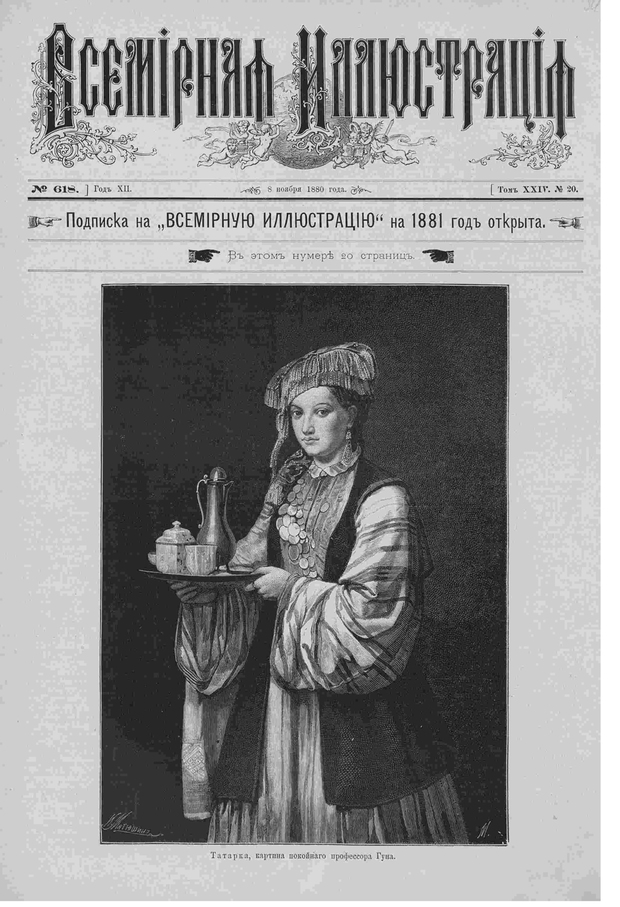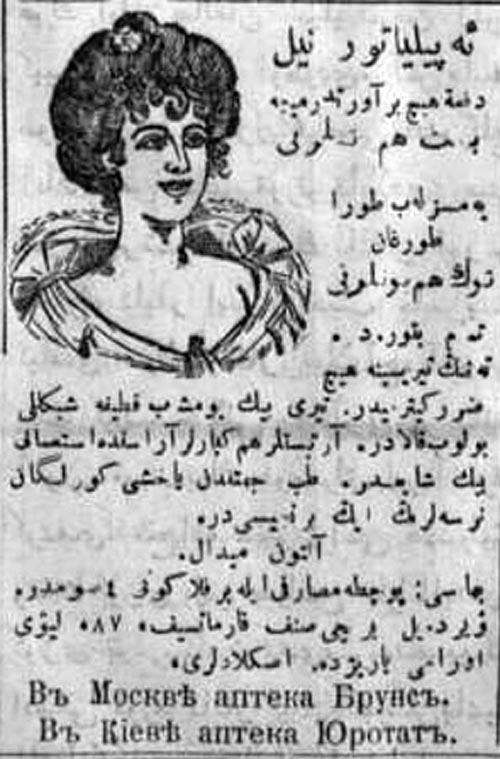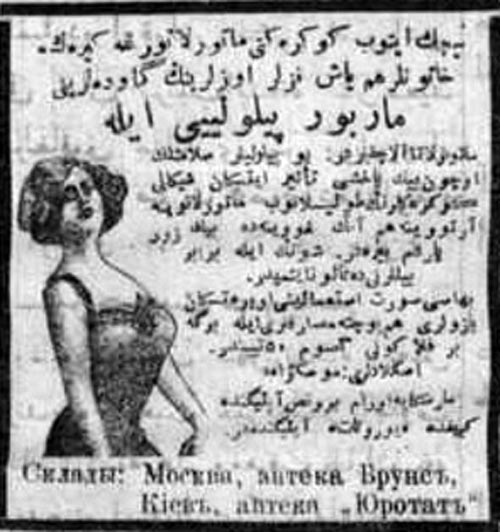Beauty industry 100 years ago: black teeth, sour shampoo and pills for high breasts
How did Tatar women wear cosmetics before the revolution?
Today almost every woman (and many men) use cosmetics and body care products to a certain degree. Representatives of the fair sex have almost always had a desire to look beautiful. However, beauty ideas changed. In a new op-ed article written for our online newspaper, Realnoe Vremya's columnist, Kazan ethnographer Dina Gatina-Shafikova told what cosmetics Tatar fashion followers used 100 years ago, what they dared to do to correspond to those ideas of beauty.
Painted ladies
Care for body and face, use of cosmetics and different spas became an indispensable part of life for a modern woman. We often use recipes given by our grandmas and great-grandmas. However, we know nothing how Tatar women cared for themselves, what they used instead of blusher or powder, to take a bath and paint nails.
Modern and 19 th-early 20th century researchers actively studied the everyday life of the Tatars and did not forget to mention such a topic as cosmetics. Describing Tatar women in the 19th century, it was often noted they wore bright make-up and used cosmetics not only on their face but also teeth and nails showing their status (the richer a woman is the more cosmetics she has at her disposal, the more often she could use them).
For instance, describing how a Tatar woman was going to visit someone in his work published in 1844, Karl Friedrich Fuchs noted she ''rubs her face with a thick layer of ceruse and the brightest Chinese blusher, tries to blacken her eyebrows especially eyelashes by all means to have brighter eyes, then she blackens her teeth and ties her nails up with a composition from the Persian powder made of dry balsam flowers (henna) mixed with alums. These ingredients paint nails in orange within a couple of hours…''
S. Monastyrsky in unison with Fuchs wrote about big love of the women for cosmetics: ''The younger and richer a Tatar woman is, the more make-up she wears and uses ceruse. It should be noted Tatars care for their appearance more than other women.''
Researcher N.O. Ryzhikov wrote the same thing in his endeavour about the geographical essay of Syzran District where he described Tatars among other ethnicities: ''…Tatar women use a thick layer of ceruse, blushers on their faces, dye their eyebrows and eyelashes and blacken teeth.''

Beauty requires sacrifice
The majority of decorative cosmetics was brought from abroad. Expensive ceruse was purchased in China and Middle Asia (white leads and Chinese ceruse); it was thinned with clean water or rose oil. They applied it on their face and neck. Cheeks were blushed with an infusion of different herbs. A cheap way was to use a purchased piece of paper soaked in water and dyed in red. Natural and thick eyebrows (that are trendy today) were not respected among Tatar women. Thin, semi-circular ones were considered beautiful. They plucked them to have a necessary form. Special tweezers were used for it. After plucking, eyebrows were dyed in black with a biennial plant in the Mustard family of 1 metre of height. In addition, this dye caused a bit of burning, and the eyebrows became bright green first, then blue and darkened to black colour in the end.
By the early 20 th century, Tatar women started to dye their eyebrows more often with purchased, factory-supplied pencils like modern girls and women. However, usual pencils for writing (thicker and softer ones) could be used often. Eyelids and eyelashes were coloured by ceruse (sulfine of ceruse, black rock crushed to powder and thinned with oil) kept in a special small metal vessel with lid that had a stick touching the bottom. This stick was dipped in ceruse that dyed the space between eyelashes, very eyelashes and lids.
Nails, teeth and hair
Nail painting is a characteristic detail frequently used by Tatar women. Describing Siberian Tatars, ethnographic essay Ethnicities of Siberia (N.N. Miklukho-Maklai Institute of Ethnology and Anthropology) published in 1956 noted that Tatar women ''borrowed nail painting in yellow (with crushed cloves) or red (with fresh balsam leaves) from Bukharian people''. Such a use of henna was a characteristic of Kazan Tatars. In addition, a mixture of dried herbs mixed with alums was used to paint nails for a more intense colour, tied up and left overnight and rinsed in the morning. Nail painting was a ritual because it was present in wedding customs of the Tatars.
Teeth blackening was spread not only among Tatars but also other Asian ethnicities. Moreover, a similar beauty procedure existed among Russians. For instance, describing a newly married woman, A.N. Radischev noted in Trip from Petersburg to Moscow she had teeth blacker than soot. N.I. Vorobiev noted this custom among the Tatars conserved until the early 20th century in ''Mamadysh, Tetyushy and in some parts of Zakamye Districts. This custom almost disappeared in Kazan… Teeth were blackened with a special powder of burr of Pistacia tree crushed to powder and mixed with mill scale from an anvil… Teeth were also coloured by an infusion of oak nuts.''
In general, G.N. Akhmarov noted about body care that ''according to Tatars, a woman's body is like a tender subject, it should not be harsh''. Describing Kazan Tatars, A. Speransky noted that both men and women paid great attention to their appearance and are notable for their especial neatness.
Tatar women washed their hair with sour milk. The ingredient was spread on the head and rinsed with hot water. It was believed washing this way not only cleaned hair from mud and dust but helped it to become strong and longer. As Tatar women did not wear hair loose but wore smooth hairdos, different styling products were used. It could be thick sugar syrup (as the cheapest product it was spread in the countryside) or the so-called pomades consisting of vaseline, bee wax, goose fat and animal salo.

To 20th century looking at the West
Tatar women also liked perfumes. As a rule, this product was imported and expensive. This is why not every woman could afford herself such a pleasure. If eastern perfumes, oils (rose oil more often) brought from Middle Asia, Turkistan and other places were used earlier and until the 19 th century, by the 20th century, Tatar women started to use products of Russian and European perfume making companies.
Many representatives of the fair sex of Tatar women especially those living in the city started to buy cosmetics made in factories. This is why ethnographer N.I. Vorobiev wrote that ''nowadays mainly European products are used to paint faces [by Tatars]… It should be noted that nowadays (the first half of the 20 th century) make-up was a rare thing, and make-up according to the rules of eastern cosmetics can be worn only by the rich but rarely''.
The situation changed a but by the early 20 th century. A tendency for less use of decorative cosmetics came about. A.A. Sukharev wrote down in his thesis Kazan Tatars (1904): ''They [Tatar women] like cosmetics – powder and ceruse, to blush and dye eyelashes with surma when they visit someone. Old people and wives of mullas painted their teeth as respect for old traditions. They also paint their nails (with burr marigold) but a bit.''

Tatar newspapers about cosmetics
Kayum Nasyri described chemical characteristics of these or that substances as not only medicinal but also cosmetic products with different origins of both inorganic compound – alums, smelling salts, etc. – and organic – oils, balsams, resins, etc. – in his paper Kazan Calendar in 1873. He also recommended natural products for use in cosmetic products – chicken egg yolks and whites, animal fats (chicken, whale and others), bee wax and others.
Publication of Syuyumbike magazine started in the early 20th century (1913). It told about different things: from family and everyday problems to birth of feminism among Tatar women. For instance, in 1914, several articles appeared in different editions about face care and use of cosmetic products. Problematic topics were also raised. For instance, many people's teeth were spoiled due to the trend for teeth blackening. An article about it appeared in an edition in 1915.
Producers of things for women could advertise their product in magazines and newspapers (thanks to this ad, today we can know some peculiarities). For instance, ad section of Al Islah newspaper tells about Nil depilator to remove unwanted hair and describes pills for women who want to have high and beautiful breasts.
So Tatar women, of course, like cosmetics and cared for themselves with pleasure. Fashion changed, of course. A greater amount of make-up was used earlier, however, like the Russian population who borrowed this kind of make-up (from the Khanate of Kazan to Petr I). But both very cosmetic products and their amount on the face changed as time went by.
